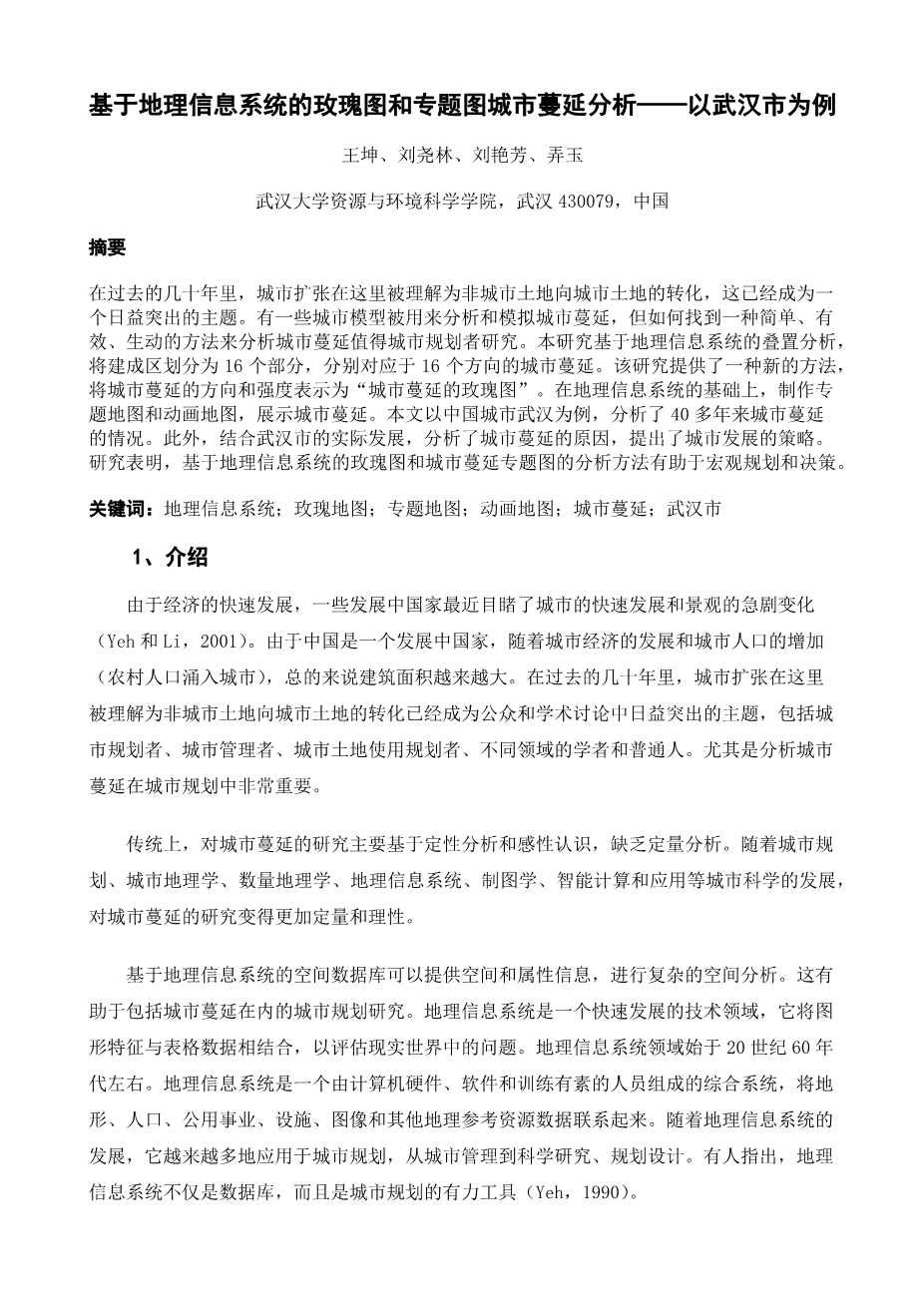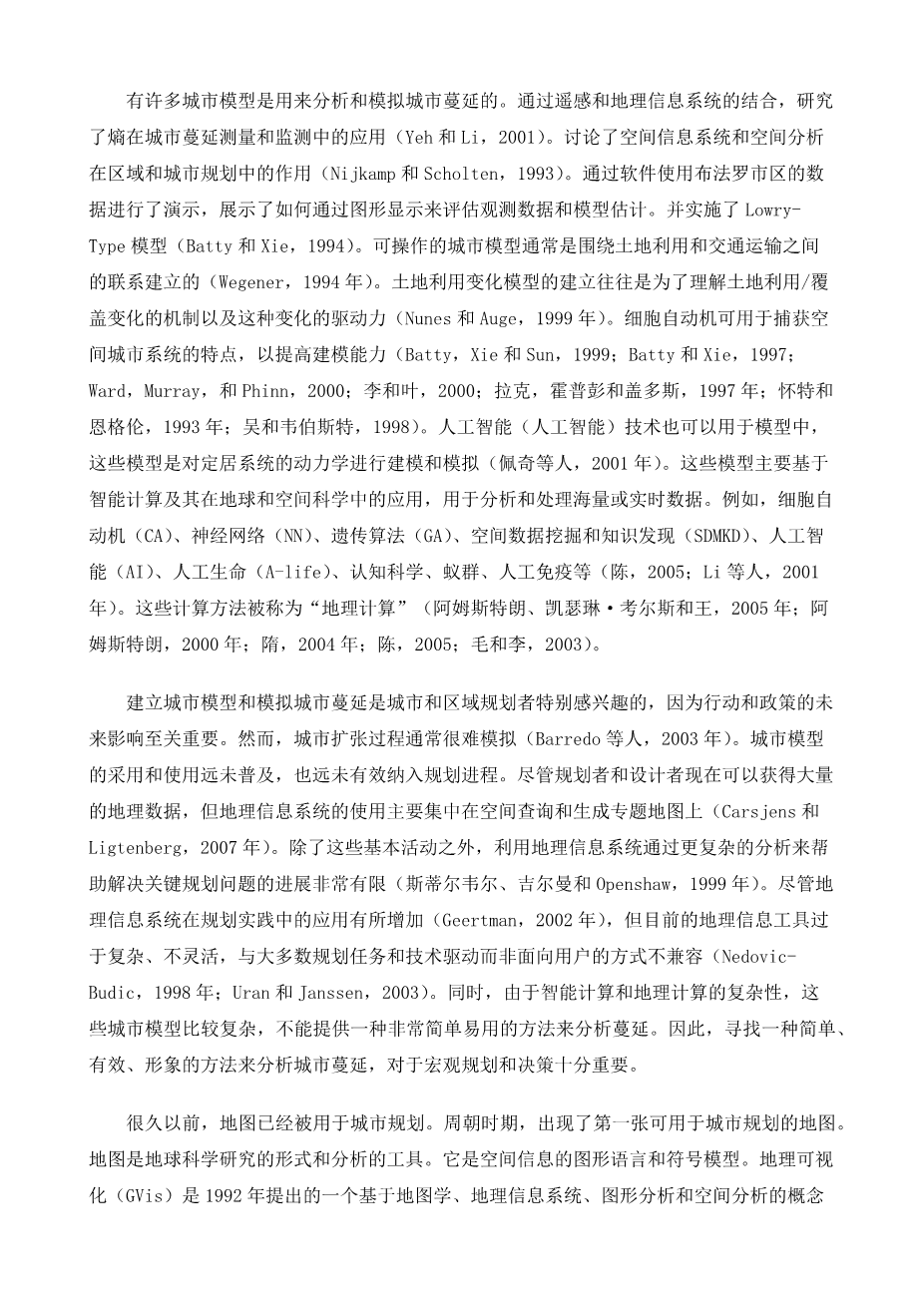Analyzing urban sprawl through rose map and thematic map based on
GIS: a case in Wuhan city, China
Kun Wang, Yaolin Liu[1], Yanfang Liu, Yu Nong
School of Resource and Environmental Science, Wuhan University, Wuhan 430079, China
ABSTRACT
Within the last decades urban sprawl being understood here as the conversion of non-urban to urban land has become an increasingly prominent theme. There are some urban models which are used to analyze and simulate urban sprawl, but it deserves study for urban planners to find a simple, effective and vivid method to analyze urban sprawl. In this study, built-up area is subdivided into sixteen parts which correspond to urban sprawl in sixteen directions based on overlay analysis of geographic information systems (GIS). The study provides a novel approach that expresses the direction and intensity of urban sprawl as “rose map of urban sprawl”. And thematic map and animated map are made to show urban sprawl based on GIS. In presenting a case study on the Chinese city of Wuhan, this paper analyzes the sprawl in more than forty years. Moreover, according to practical development of Wuhan city, the reasons of urban sprawl are analyzed and the strategies of urban development are brought forward. The study thus shows that it is helpful for macro-planning and decision-making to have an analytical method available through rose map and thematic map of urban sprawl based on GIS.
Keywords: GIS; rose map; thematic map; animated map; urban sprawl; Wuhan city
1. INTRODUCTION
Rapid urban development and dramatic change of landscape have been recently witnessed in some developing countries as a result of rapid economic development(Yeh and Li, 2001). Because China is a developing country, with the development of urban economy and the increasing of urban population (rural population swarming into city), the built-up area becomes increasingly big in general. In the last decades urban sprawl being understood here as the conversion of non-urban to urban land has become an increasingly prominent theme in both public and academic discussion, including urban planners, urban administrators, urban land use planner, the scholars in the different fields and the common people. Especially, analyzing urban sprawl is very important in the urban planning.
Traditionally, the research of urban sprawl mainly bases on qualitative analysis and perceptual knowledge and is short of quantitative analysis. With the development of urban science such as urban planning, urban geography, quantitative geography, geographical information system (GIS), cartography, intelligence computation and applications, the research of urban sprawl becomes more quantitative and more rational.
GIS-based spatial data base can provide spatial and attribute information and carry out complicated spatial analysis. It is helpful for the research of urban planning including urban sprawl. GIS is a rapidly growing technological field that incorporates graphical features with tabular data in order to assess real-world problems. GIS field began around 1960s. GIS is an integrated system of computer hardware, software, and trained personnel linking topographic, demographic, utility, facility, image and other resource data that is geographically referenced. With the development of GIS, it is increasingly used for urban planning, from the urban administration to science research, planning and designing. It was pointed out that GIS was not only data base but also a powerful tool box for urban plan(Yeh, 1990).
There are many urban models which are built to analyze and simulate urban sprawl. The use of entropy was examined in the measurement and monitoring of urban sprawl by the integration of remote sensing and GIS(Yeh and Li, 2001). The role of spatial information systems and spatial analysis in regional and urban planning were discussed(Nijkamp and Scholten, 1993). A pass was illustrated through the software using data for the Buffalo urban region, showing how observed data and model estimates can be evaluated through graphic display. And Lowry-Type models were implemented(Batty and Xie, 1994). Operational urban models are often built around the link between land use and transport(Wegener, 1994). Land use change models are often built to understand the mechanism of land use/cover change and the driving forces for such change(Nunes and Auge, 1999). Cellular automata may be used to capture spatial features of urban systems to improve modeling capacity(Batty, Xie, and Sun, 1999; Batty and Xie, 1997; Ward, Murray, and Phinn, 2000; Li and Yeh, 2000; Clarke, Hoppen, and Gaydos, 1997; White and Engelen, 1993; Wu and Webster, 1998). Artificial intelligence (AI) techniques may also be adopted in models, which were modeling and simulating the dynamics of settlement systems(Page et al., 2001). These models mainly bases on intelligence computation and its application in earth and space sciences for analyzing and processing massive or real-time data. For example, cellular automata (CA), neural networks (NN), genetic algorithms (GA), spatial data mining and knowledge discovery (SDMKD), artificial intelligence (AI), artificial life (A-life), cognitive science, ant colony, artificial immune, and so on(Chen, 2005; Li et al., 2001). These computational methods are called “GeoComputation”(Armstrong, Kathryn Cowles, and Wang, 2005; Armstrong, 2000; Sui, 2004; Chen, 2005; Mao and Li, 2003).
Building urban models and simulating urban sprawl are of particular interest to urban and regional planners since the future impacts of actions and policies are critically important. However, urban sprawl processes are usually difficult to simulate(Barredo et al., 2003). The adoption and use of urban models is far from widespread, a
剩余内容已隐藏,支付完成后下载完整资料


英语译文共 13 页,剩余内容已隐藏,支付完成后下载完整资料
资料编号:[436544],资料为PDF文档或Word文档,PDF文档可免费转换为Word
以上是毕业论文外文翻译,课题毕业论文、任务书、文献综述、开题报告、程序设计、图纸设计等资料可联系客服协助查找。
您可能感兴趣的文章
- GIS矢量地图的鲁棒水印方案外文翻译资料
- 中国相似地理位置发达地区房价影响因素的差异——以西安高新区和沣渭新区为例外文翻译资料
- 集成数据在城市土地利用变化时空动态监测的应用——以印度金奈都市为例外文翻译资料
- 全球地表水及其长期变化的高分辨率制图外文翻译资料
- 造成沿海大型城市内涝灾害的主要因素识别——以中国广州为例外文翻译资料
- 基于SFPHD框架的中国快速城市化地区城市生态系统健康综合评价方法外文翻译资料
- 基于绿地演变的未来城市地表热岛强度的多情景模拟预测外文翻译资料
- 中国大陆272个城市地面和冠层城市热岛强度的长期趋势外文翻译资料
- 与孟加拉湾热带气旋有关的中国低纬度高原远距离降雨事件外文翻译资料
- 新丰江水库流域GPM IMERG降水产品评价及水文效用研究外文翻译资料


